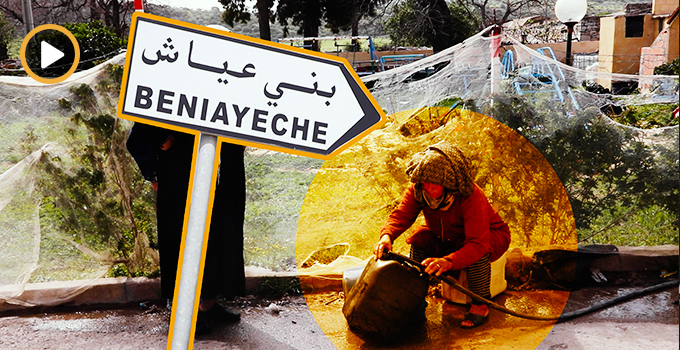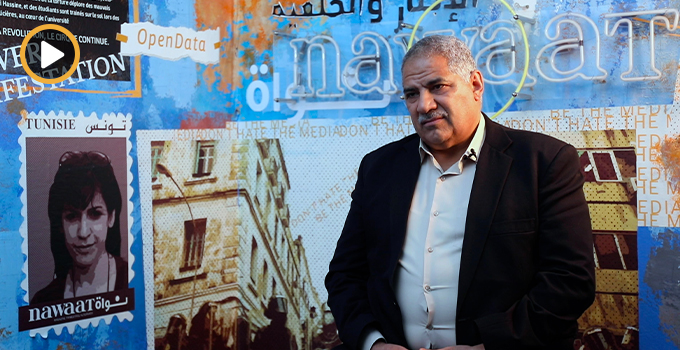The road to Jemna…
…is an orientalist’s vision. Heading south from the capital, the landscape turns dry and expansive, beige sand stretching to the horizon and intermittent oases of trees that have finished their offering of dates for the season. Every few kilometers or less, young men stand at the side of the road holding containers piled high with small green ovular fruits at the center of which are louz—fresh almonds. At a rest stop along the way we pluck a handful from a tree by the paved lot, bite into the hard, bitter shell and extract the small white nut inside —an almond so fresh that it bleeds a refreshing milk. Drawing into the country’s interior, one passes herd after herd of white and brown goats, a field flecked with dozens of dark spots that, the observer remarks upon nearing, take the shape of camels.
After seven hours of driving, we reach the governorate of Kebili, where green oases of date palms cover swaths of land here, the cultivation of dates is the primary agricultural and economic activity. In the town of Jemna, residents have formed an association dedicated to the preservation and cultivation of 185 hectares of what are considered collective lands for the production of dates. The Association for the Protection of Jemna’s Oases is composed of 129 workers including farmers and security guards, three supervisors responsible for overseeing the workers and managing administration and finances, plus one general supervisor. Nawaat has traveled to meet with the individuals who have taken over the oases in the name of Jemna and its residents.
Borj Merillon

At five-thirty in the morning, we turn off Jemna’s main road and drive between two high walls of palms that lead to a clearing. Here we stop just as workers to begin to arrive one by one on motorcycle. They gather by the door of a cube-shape, earth-colored building, “Bordj Merillon“, where they wait, smoking, talking quietly. When all are present after a quarter hour, the men disappear inside the building and emerge carrying various tools- shovels, rakes, a five-foot long instrument with a tooth-edged circular blade at one end. With impressive ease, the workers climb onto their motorcycles, sometimes two to a bike, carrying the cumbersome equipment and disperse into different directions and out of sight.

We follow the three supervisors and several advisors into the borj, a remnant of French colonization. The weather-worn building once served as a citadel and offers a nearly 360-degree view of the surrounding land which has been managed and exploited by a number of State-affiliated and private operators over the years. Under the French, the Société Commerciale et Agricole du Sud Tunisien (SCAST) was created as new urban centers were established and Deglat Nour date palms planted as means to exert control over the land and its inhabitants.1 After Tunisia’s independence, the oases in Jemna were taken over by the Société Tunisienne d’Industrie Laitière (STIL).2 According to Taher Tahri, one of the Association’s founding members, the government sold the land without majority approval of Jemna’s management council (Conseil de Gestion de la Localité de Jemna), rendering the transaction illegal. From 2002 until 2011, the oases were exploited by two independent operators, a private contractor and the brother of an official working in Ministry of the Interior under Ben Ali.
State, to Private, to Public: Residents take over the oases

Two days before Ben Ali fled the country, Jemna residents (particularly those affiliated with the League for the Protection of the Revolution) staged a sit-in to take over the 185 hectares of land that had long been exploited with little return for the local population. Over a period of three months and ten days, tents were set up, food was prepared, and entertainment organized to attenuate what remained nonetheless a heavy atmosphere.
During the same period, funds were raised to purchase materials and equipment to take over and maintain the oasis. With a contribution of thirty dinars each, residents raised 34 thousand dinars (approximately 17.7 thousand US dollars). Several months later, the group which had led the demonstration created the Association for the Protection of Jemna’s Oases. In one after another of the country’s successive governments since 2011, Association members have met with representatives of Ministry of State Property and Land Affairs and the Ministry of Agriculture and Sustainable Development. Each time, reports Taher Tahri, officials have acknowledged residents’ right to manage the oases in Jemna, but no decisive action has been taken to grant the Association legal status.
Without this official recognition, the Association is unable to provide workers with social security benefits through the National Social Security Fund (CNSS). To compensate, explains Association accountant Tarek Rahmouni, workers’ salaries are supplemented with an extra 1 dinar 900 millimes per day which recipients must take upon themselves to pay towards coverage through CNSS. Rahmouni says that overall wages have increased since 2011 from 10 to 15 dinars 400 millimes per day.
Though Association workers do not benefit from health coverage, locals benefit far more from profits earned from the 185 hectares of collective lands than throughout the decades preceding 2011. Taher Tahri recounts that the land’s previous tenants paid the State negligible sums of money —9 thousand dinars per year to cultivate 111 hectares and 5 thousand dinars per year for 74 hectares—given profits earned from the sale of dates produced on the oases. Tahri reports, for example, that the Association earned 969.5 thousand dinars after its first year managing the oases, and nearly double the amount —1.8 million dinars— in 2014. The Association not only now employs more workers throughout the year with higher salaries than in previous years, but invests in infrastructural improvements and sponsors recreational and cultural activities in Jemna, and also contributes to academic, cultural, environmental projects in Kebili, Mansoura, Douz, and Gafsa.
The Workers
In a field not far from the Bordj, six men are shoveling single file beneath the shade of a row of palms, building up the border of an irrigation canal. Harvest season having ended in April, workers are weeding, cleaning, planting, and rebuilding the irrigation channels that traverse wide strips of land planted with trees.
Some of these men have worked here since private operators were in charge of the oases. Ali Al Abad recalls when six or seven men were responsible for maintaining 74 hectares of palms. According to Al Abad, a bare minimum was invested in the workers and the trees in order to maximize profits. Sami Khamar who has been raking cut weeds into piles and Saleh Belgaid who has been planting starters remark that there was a great deal of unemployment before the revolution, especially among the region’s youth. Now there is work, productivity, and people are able to provide for their families.

Not Just Material, but Moral Support
Abd Hamid Zayd oversees the construction projects financed by the Association. We meet Zayd at the site where work commenced in December to construct a 1,400 square-meter building for Jemna’s daily and weekly markets. Until now, vendors have set up in a lot just off the main road to sell dates Sunday through Wednesday, and a variety goods —from produce to clothing— on Saturday. The cost of the project totals 550 thousand dinars and is scheduled for completion in July.
Other construction projects include the gate and surrounding wall of Jemna’s cemetery, a recreational field, and infrastructural improvements at two elementary schools. Teacher Belgacem Cheyb and principal Bechir Hachani indicate that some 250 thousand dinars have gone to maintenance and building repairs, the addition of facilities including a library, a faculty room, a snack bar, and to sponsor sports activities. Our interlocutors express that the support afforded Jemna’s schools is not just material, but moral.
Indeed, integrity and accountability to residents appear to be singular features of Jemna’s Association. Tarek Rahmouni recounts that when the group took over the land in 2011, it cleared out equipment that had been left behind by the previous tenants and returned it to the owners. Taher Tahri explains that the Association has tried -without success- to pay taxes on the land it manages (at one point, steps were taken to register the Association as a company, but some locals refused the transformation, perhaps fearing that profits would be absorbed by management as in previous years).
That the Association has been unable to provide CNSS benefits remains an issue for workers, though in general what the collective lacks in papers and titles, it seems to bear in public approval. Association employees and members with whom we have spoken exhibit a sense of ownership and personal investment in managing the oases as a collective resource. Belgacem Cheyb observes that the increased productivity of the oases is a source of encouragement for those who have worked to reclaim and manage the land for the benefit of locals; residents of Jemna see that their efforts have born fruits and want to keep that internally-driven resource management and local development going.
Notes
1. Pages 36-37, Strategy for the Sustainable Development of Tunisia’s Oases prepared by the General Direction for Environment and Quality of Life, Ministry of Environment and Sustainable Development. March 2015. [Translated]. Referring to the changes in Tunisia’s southern territories implemented by the French, the authors of the report note that «These developments, though they reestablished a certain ecological equilibrium, did not allow for the improvement of revenues of the populations and the quality of life».
2. “In 1962, STIL (Tunisian Dairy Industry Company) was designated the responsibility of managing the former colonial domains in Jerid and Nefzaoua. The State also granted it a monopoly in the commercialization of dates in Tunisia and abroad and this according to national selections in favor of the public sector and exchange control. The aim was to preserve the flux of currencies from the exportation of dates in order to finance industrialization and various State-backed projects.
“STIL benefits from all advantages: access to credits, a massive workforce with very low salaries, availability of water for irrigation, creation of modern palm plantations cultivated exclusively for Daglet Nour, purchase of dates in productive regions at low price, promotion of dates in its packaging factory in Tunis. Thus STIL constituted a veritable agro-food company which managed the whole of the industry enabling it to reduce its production costs and accumulate profits.” Page 68, Strategy for the Sustainable Development of Tunisia’s Oases.





iThere are no comments
Add yours